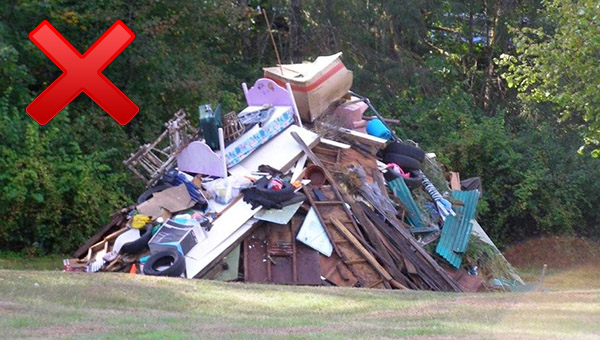Tips on Burning
Where there’s fire, there’s smoke. However, smoke can be a serious health threat – especially to children, the elderly and people with heart or lung impairment. Keep a close eye on your smoke to gauge the success of your burn. In addition to conforming to the above requirements, burn piles must (by regulation) be managed in such a way that smoke production is minimized. Here are some tips based on years of experience.
Prepare Your Burn
- Construct piles loosely, with spaces to allow adequate oxygen to reach the burning material.
- Construct piles intelligently, in a dome or teepee shape that allows heat to build so that flames can be maintained and the vegetation can be consumed rapidly. Flat, sprawling piles rarely burn well.
- Create a “heart” of fine, flammable vegetation such as dry scotch broom and light it down low on the side the wind is coming from.
- Check berry vines for excessive moisture by breaking a thick cane and squeezing the pith — many people have accidentally offended their neighbors by burning wet berry vines that were dry on the outside.
- Make sure your pile is clean (another regulatory requirement); an archenemy of a good burn pile is dirt, which concentrates as the vegetation burns away, reducing airflow.
- If you have a large pile or multiple piles, light a small test fire first, to make sure the smoke goes up and away from neighbors.
- Try to burn when a storm is approaching (and the air pressure is dropping); smoke dispersion is usually pretty good then. In general, low air pressure equates to better smoke dispersion. Observe wood stove smoke in your area to get an idea of how your smoke is likely to behave.
Tending Your Burn
- Use a hat (as a fan), leaf blower or tractor fan to force air into the pile as needed.
- Wear gloves and keep tools on hand to manipulate branches and fluff the pile up as needed, and turn protruding, smoking branches in to the flames (you can shield the heat from your face with a shovel or a leather hat if necessary, and don’t wear loose, flammable clothing such as an unbuttoned overshirt).
- Arrange slightly damp leaves and brush around the active pile to dry them before adding them to the pile.
- Don’t burn all the small branches first. Pace the addition of small stuff to maintain flames as needed. Likewise, be aware of how well various plants burn — manzanita, buckbrush and broom can be gradually added to keep less flammable plants such as hardwoods and ornamentals burning well. English laurel is especially notorious for burning poorly and creating irritating smoke.
- Stay with your pile and make sure it burns hot and clean. When it has burned down to coals, put it out with water if possible instead of letting it smolder all night (extinguished coals can be good for a garden).
- If your fire is not going well, or smoke is blowing toward a neighbor’s house, it is perfectly honorable and neighborly to put it out and wait for another day.
Things Not to Burn

- Never burn household garbage or cardboard. Plastics, foam and the colored ink on magazines, boxes, and wrappers produce harmful chemicals when burned. They may also damage your wood-burning appliance.
- Never burn coated, painted, or pressure-treated wood because it releases toxic chemicals when burned.
- Never burn ocean driftwood, plywood, particle board, or any wood with glue on or in it. They all release toxic chemicals when burned.
- Do not attempt to burn large stumps in a residential area, and avoid burning punky logs that are well on their way to enriching the soil.
- Try to avoid burning poison oak. While medical opinions vary, extensive anecdotal evidence indicates that the smoke can cause an allergic reaction.
